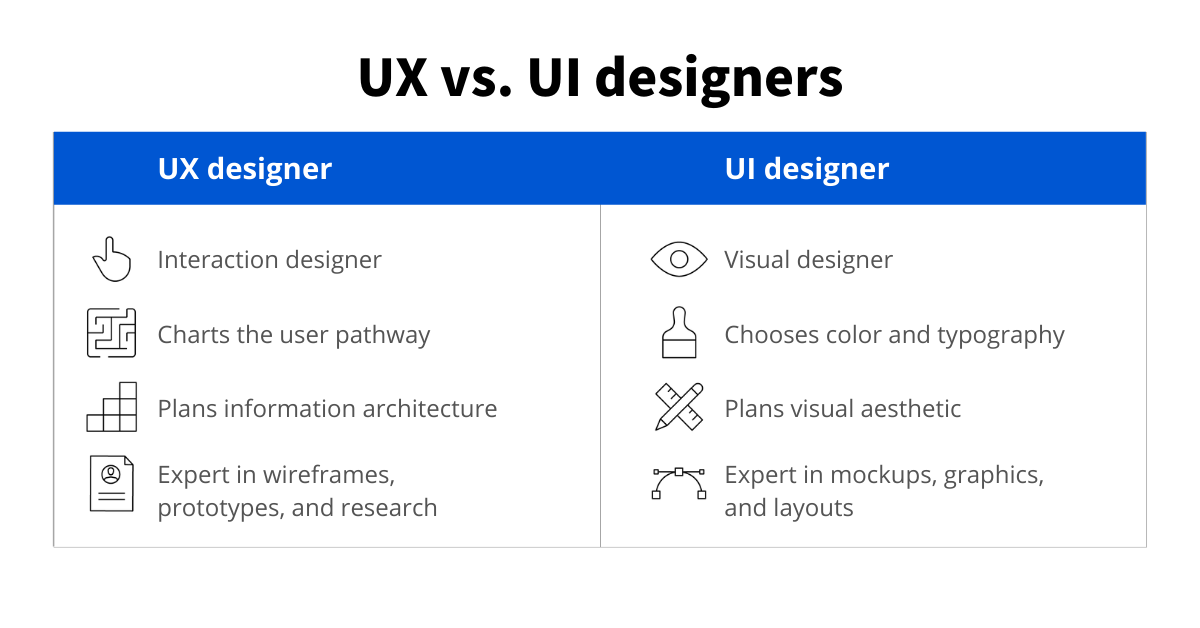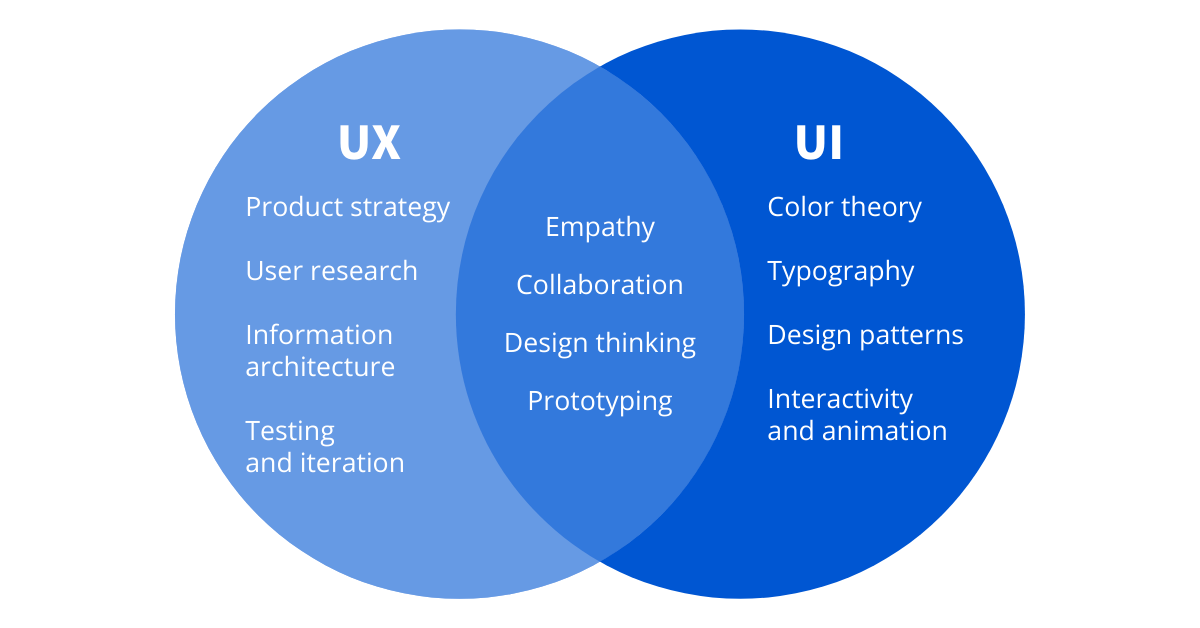
UI vs. UX Design: What’s the Difference?
User interface (UI) and user experience (UX) are two words that you might hear mentioned frequently in tech circles (and sometimes interchangeably). But what do the terms actually mean, and what does it mean to be a UX or UI designer?
In this article, we’ll take a closer look at how the roles of UX designer and UI designer overlap and differ, and how to know which you should pursue. Finally, we’ll discuss options for getting started, even if you don’t have a degree or previous experience.
Difference between UI and UX
UI refers to the screens, buttons, toggles, icons, and other visual elements that you interact with when using a website, app, or other electronic device. UX refers to the entire interaction you have with a product, including how you feel about the interaction. While UI can certainly have an impact on UX, the two are distinct, as are the roles that designers play.
Developing a product that people love often requires both good UI and good UX. For example, you could have a banking app that looks great and has intuitive navigation (UI). But if the app loads slowly or makes you click through numerous screens to transfer money (UX), it doesn’t matter how good it looks. You’re probably not going to want to use it.
On the other hand, a website could be loaded with unique, helpful content organized in a logical and intuitive way. But if it looks dated or you can’t easily figure out how to move between screens or scroll through options, you’re likely to click away from the site.

Tasks and responsibilities: What do they do?
Both UI and UX designers play key roles in the product development lifecycle. Let’s take a closer look at each.
UX designers focus their work on the experience a user has with a product. The goal is to make products that are functional, accessible, and enjoyable to use. While the term UX often applies to digital products, it can also be applied to non-digital products and services (like a coffee pot or a transportation system). Common tasks for a UX designer might include:
Conducting user research to identify any goals, needs, behaviors, and pain points involved with a product interaction
Developing user personas based on target customers
Creating user journey maps to analyze how a customer interacts with a product
Building wireframes and prototypes to hone in on what the final product will look like
Performing user testing to validate design decisions and identify problems
Collaborating with stakeholders, UI designers, and developers
Learn more: What Does a UX Designer Do?
UI designers create the graphical portions of mobile apps, websites, and devices—the elements that a user directly interacts with. Unlike UX, which can apply to just about any product or service, the term UI applies exclusively to digital products. A UI designer seeks to make apps and websites both visually appealing and easy to navigate. Common tasks of a UI designer include:
Organizing page layouts
Choosing color palettes and fonts
Designing interactive elements, such as scrollers, buttons, toggles, drop-down menus, and text fields
Making high-fidelity wireframes and layouts to show what the final design will look like
Working closely with developers to convert designs into a working product
Learn more: What Is a User Interface (UI) Designer?
Become job-ready in just two months with Microsoft's UX Design Professional Certificate:
Is there such a thing as a UI/UX designer?
Search for UX on job listing sites, and you’re likely to find companies looking for UI/UX designers. Some companies do sometimes look for candidates with both sets of skills. But often when you start looking more closely at these listings, you’ll find the role leans more towards one than the other.
When it comes time to begin your job search, pay more attention to the list of tasks or qualifications than the specific job title.
Skills
UI and UX designers have some skills in common, but each role also requires its own unique skill set.

Education
While a degree isn’t always necessary to get a job as a UX or UI designer, having one can often open up new opportunities. Only a few universities offer programs specific to UI/UX. UX designers might get a degree in computer science, psychology, human-computer interaction, or design. UI designers, on the other hand, might graduate with a degree in digital design, graphic design, or interaction design.
Salary
According to Glassdoor, the average salary for UX designers in the US, including base pay and additional compensation such as commission and bonuses, is $94,260 [1]. That figure was $98,758 for UI designers [2]. Your salary could depend on many factors, including your location, industry, amount of experience, and educational background.
How do I know if UI or UX is a better fit for me?
Both UI and UX design are well-paying careers that are in demand. Which you choose to pursue will depend on your goals and interests. If you’re interested in technology, thrive on variety, and love to solve problems, user experience design might be a good fit. If you’re a creative thinker with a strong aesthetic sense, consider pursuing user interface design.
If you’re still not sure whether UI or UX is a better fit for you, you can:
Take a class in each to experience them for yourself
Read or listen to popular UI/UX blogs and podcasts to hear from experts in each field
Reach out to industry professionals on LinkedIn for an informational interview
Join some online design communities to ask questions
Read more: How to Choose a New Career (Coursera Career Research Guide)
Consider a career path in front-end development:
Other user experience roles
The field of UX extends beyond the two roles of UI and UX designers. If you’re interested in a career in UI/UX, consider these other related roles as well.
UX researchers study the goals, needs, wants, and pain points of a product’s existing and target users.
UX writers write the text that appears on websites, apps, and other digital products.
Interaction designers focus on the ways users interact with digital products in a holistic context.
Developers take the designs from UI and UX designers and code them into usable software, websites, or applications.
Product designers lead the entire process of taking a product or service from idea to reality.
Content strategists oversee the planning and production of marketing content through the lifecycle of a project.
Build your UX design career
The good news is that you don't have to choose between UI and UX, because strengthening each skillset makes you a well-rounded designer. Build your skills with these top-rated and online courses from Coursera:
To develop your UI skills, try Google's course Build Dynamic User Interfaces (UI) for Websites that is part of the popular UX Design Professional Certificate. Using Adobe XD, you'll apply design thinking, along with information architecture and sitemap planning, to create a dynamic website.
To apply your UI skills to a real-world project, enroll in the guided project User Interface (UI) Design with Wireframes in Miro. In this two-hour course, you'll use Miro (a widely used tool in UX design) and improve the user experience of a UI wireframe map.
To build foundational knowledge in UI and UX, consider CalArts' UI / UX Design Specialization for a comprehensive four-course series that can be completed in two months. Zoom in on each stage of the UI and UX development process, from user research to strategy, scope, and information architecture, to developing sitemaps and wireframes.
Frequently asked questions (FAQ)
Link nội dung: https://nhungbaivanhay.edu.vn/ui-and-ux-a41557.html